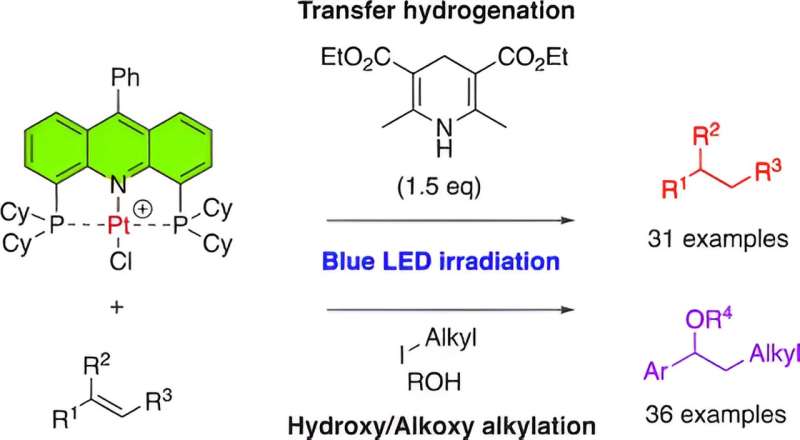This article has been reviewed according to Science X's editorial process and policies. Editors have highlighted the following attributes while ensuring the content's credibility:
fact-checked
peer-reviewed publication
proofread
Team develops novel ligands for transition-metal catalysis of photoreactions

Transition metals form catalytic complexes that can speed up various chemical processes, especially in the production of pharmaceuticals as well as various pigments, dyes, and laboratory reagents like sulfuric acid. The use of light emitting diodes (LEDs) has boosted the use of visible light in reaction catalysis, and scientists have developed photo-redox catalysts made of iridium and ruthenium, which facilitate catalysis when irradiated with specific wavelengths of light.
Additionally, scientists have even demonstrated visible light photoreactions with palladium complexes without the use of photo-redox catalysts. While several such transition metal-catalyzed photoreactions have been developed, there has been limited development of new ligands for these reactions; most studies used existing ligands that were developed for thermal reactions.
Thus, there has been a notable lack of development of ligands that interact specifically with transition metal catalysts in photoreactions, preventing us from unlocking the true potential of such reactions.
Recently, a team of researchers, led by Professor Tetsuhiro Nemoto from the Graduate School of Pharmaceutical Sciences at Chiba University in Japan, developed novel ligands that can be used in photoreactions with transition metal catalysts. They also demonstrated how the developed ligands interacted with different transition metals to produce different catalytic results for photoreactions.
The team included Mr. Yu Matsuda from the Graduate School of Pharmaceutical Sciences at Chiba University and Dr. Masaya Nakajima, who was affiliated with the same institute at the time of the study but is now affiliated to the Graduate School of Pharmaceutical Sciences at the University of Tokyo. Their work was published in ACS Catalysis.
The researchers utilized commercially available 9-phenylacridine to prepare four acridine-containing PNP-pincer ligands, which were then used to create complexes with nickel, palladium, platinum, copper, and cobalt.
The team evaluated the catalytic activity of the complexes for a specific photoreaction called transfer hydrogenation, a common reaction used in various industries. While the nickel complex did not react efficiently, the palladium and platinum complexes successfully catalyzed the reaction to provide a high yield of the final products.
Specifically, the researchers found that the newly developed ligands allowed the platinum complex to successfully catalyze a reaction in the presence of visible light (blue LED irradiation) in a stoichiometric manner. This means that the exact values of reagents needed, and the quantity of product obtained, can be mathematically calculated.
The preciseness of the catalysis will allow the streamlining of industrial processes, such as in the production of medicines. Furthermore, the new platinum complex could catalyze the hydroxy/alkoxy alkylation of olefins—a reaction that could not be catalyzed with existing well-known ligands.
The fact that these photoreactions did not occur in the presence of well-known ligands highlights how the newly designed ligands could help define new reaction capabilities. Explaining the results, Dr. Nakajima says, "This research reveals a new reactivity of platinum that was previously unknown. As a result, it has become possible to synthesize new kinds of molecules more efficiently, potentially finding applications in the manufacturing of novel materials and pharmaceuticals."
The present study is also expected to have numerous long-term implications. "Visible light is utilized as the energy source for such reactions. Thus, sunlight can be used as an endless source of energy, and technological advancement could allow us to perform photoreactions without the constraints that come with the arrangements necessary for thermal reactions, ultimately helping us resolve emerging energy issues," concludes Dr. Nakajima.
Indeed, the development of new ligands for transition metal complex photocatalysis can create new possibilities and redefine reaction capabilities, allowing novel solutions to the challenges we face today.
More information: Yu Matsuda et al, Acridine PNP-Pincer Ligands Enabling Transition Metal-Catalyzed Photoreactions, ACS Catalysis (2023). DOI: 10.1021/acscatal.3c01654
Journal information: ACS Catalysis
Provided by Chiba University




















